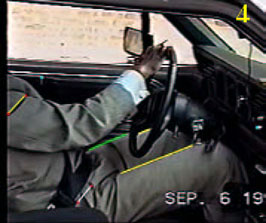More information
Main author
Strauss, M.
Co-Authors
-
Type of media
-
Publication type
Lecture
Publication year
2002
Publisher
11. EVU-Jahrestagung, Portoroz 2002
Citation
Strauss, M.: The Biomechanics of a Low-Speed Rear-End Collision. 11. EVU-Jahrestagung, Portoroz 2002

Video frame from the simulation videotape
English, 7 pages, 5 figures, 2 references
Keywords: Biomechanic, low-speed collisions
This is a case study of how a complex low speed collision can be analyzed without a human computer model. This collision occurred as three cars were in line as they were approaching a toll booth. The front car was barely rolling forward, the middle car was stopped and the last car was moving at less than 16 km/h. The last car struck the rear of the middle car, which then rolled into the front car. The driver of the front car claimed that the impact from the middle car caused injuries to his knees. This was an interesting project to investigate because: there were more than two vehicles that collided; it involved an alleged failure of a component (the seat back); the transmission was shifted while the vehicle was rolling; and the biomechanical analysis of the driver had to take into account three different input events, the initial impact, the body rotation backwards and the body moving forwards to strike the instrument panel. The article depicts the way the accident was reconstructed: In this case, the sometimes-assumed reconstruction parameters such as vehicle stiffness, coefficients of restitution, deceleration, linked body segment dimensions and moments of inertia need not be calculated nor experimentally evaluated. It was determined that the driver could not have pushed the gearshift lever into park with his knee due to a rear impact to the car. It was also demonstrated that the knees would not have impacted the steering wheel, and cause the injuries claimed.